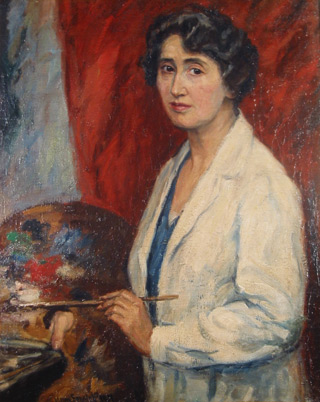Written by: Dr Pnina Rosenberg

Schaleck was born in Prague on 18 February 1882, to a wealthy and cultured
Jewish family, which came originally from Bohemia. She was the youngest of four
children. On the ground floor of the building in which the family lived was a large
book shop, which they owned, along with a lending library, a music library (Musik
Schaleck) and a furniture store (Möbel Schaleck) in other parts of the city.
Her grandfather (Josef) and father (Gustav) took part in the cultural and
political activities of the Czech nationalist movement, and the bookshop was a salon
for intellectuals, an activity which did not cease even after her father’s sudden death
(1889) and was continued by her mother, Judith, née Wohl. Several years later, her
mother remarried Dr. Schnitzer, and the family moved to Hohenelbe, where Malva
completed her secondary school education. Afterwards she moved to Munich, where
for a year she studied art at the Frauenakademie. Then she moved to Vienna, where
she opened a studio. Relatives who lived there helped her financially and with social
connections. While in Vienna, Schaleck acquired a reputation as a portrait artist —
with the subjects of her paintings being mainly middle- and upper-class Jews. Her
reputation as a portrait artist also reached Prague.
Schaleck’s Uncle Peppi, a banker, who was the brother-in-law of Johann
Strauss Jr. and very involved in artistic circles in Vienna, was very proud of her
artistic work, and set up a studio for her in the building of the Theater an der Wien.
He even introduced her to artists and members of high society in Vienna, some of
who became models for her works, as. for example, Katerina Schratt, who was the
mistress of the Kaiser, Franz Josef. Malva Schaleck was also involved in artistic
circles, which included the composers Johann Strauss Jr. and Brahms.
After the Anschluss – the annexation of Austria to Germany – in March 1938,
and the introduction of anti-Semitic laws by the Nazis, Schaleck fled Vienna, leaving
behind all her works in her studio. She was accompanied by her aunt, Emma Richter,
whose son had been murdered a short time previously by the Nazis because of his
political activity. The two moved to Leitmoritz in Czechoslovakia, where Malva’s
brother, Robert, who was a policeman in the city, lived. Her life there was
characterized by fear and distress. She was dependent on the generosity of many
people, and while in flight she learned of the terrible fate of some of her family.
In 1942 Malva Schaleck was transported to the Theresienstadt ghetto, which was a
time of great physical difficulties and emotional distress for her. In Theresienstadt,
despite her failing health, she painted many works in secret, in which she depicted
scenes of life in Theresienstadt. Her works, done in pencil, charcoal and watercolors,
were hidden in the walls of the buildings and discovered after liberation. They are a
faithful testimony to various aspects of the living conditions in the Theresienstadt
ghetto-camp.
After refusing to draw a doctor who was a collaborator, Malva Schaleck was
sent to Auschwitz on 18 May 1944 and perished there. A large number of Malva
Schaleck’s works were donated to the Ghetto Fighters’ House Museum art collection
by her niece and nephew, Lisa Fittko and Hans Eckstein.
References
Beit Thereseinstadt (Thereseinstadt House) archive, Givat Haim-Ihud, Israel
Janet Blater and Sybil Milton, Art of the Holocaust, Pan Books, London, 1982.
Mary S. Constanza, Living Witness: Art in the Concentration Camps and Ghettos,
The Free Press, New York, 1982.
Lisa Fittko, Solidarity and Treason: Resistance and Exile 1939-1940, Northwestern
University Press, Evanston, Illinois, 1993.
Miriam Novitch, Spiritual Resistance: Art from concentration Camps 1940-1945 – A
selection of drawings and paintings from the collection of Kibbutz Lohamei
Haghetaot, Union of American Hebrew Congregation, 1981.
Pnina Rosenberg, Images and Reflections: Women in the Art of the Holocaust. The
Ghetto Fighters House Museum, 2002.
Pnina Rosenberg, "Malva Schalek: A Resistance Artist in Terezín," Prism: An
Interdisciplinary Journal for Holocaust Educators, Vol. 12, 2020, pp. 37-44.
Sabine Zeitoun & Dominique Foucher (eds.), La masque de la barbarie: le ghetto de
Thereseinstadt 1941-1945, Milan Kunda, Préface, Centre d’Histoire de la Résistance
et de la Déportation, Ville de Lyon, 1998.